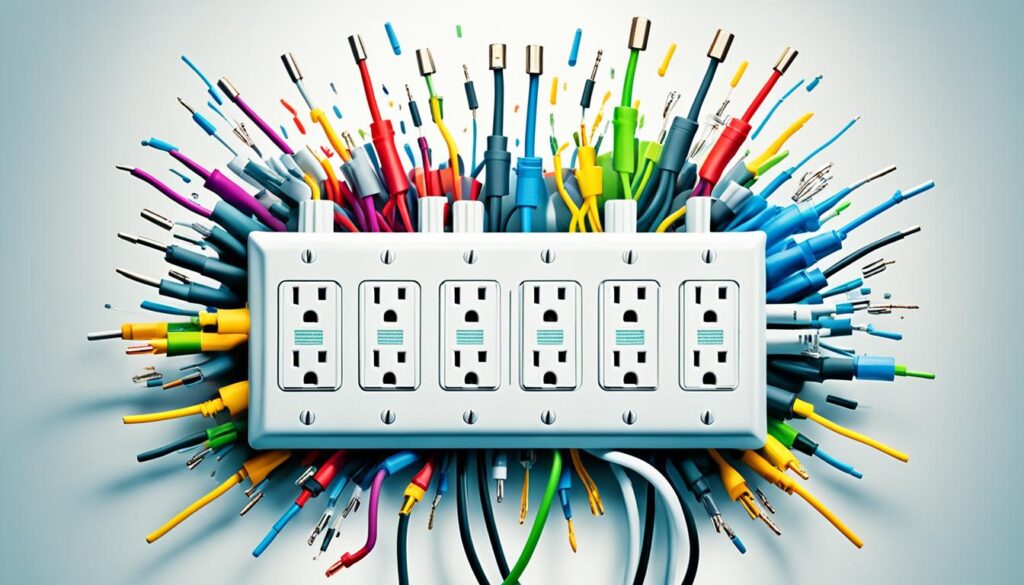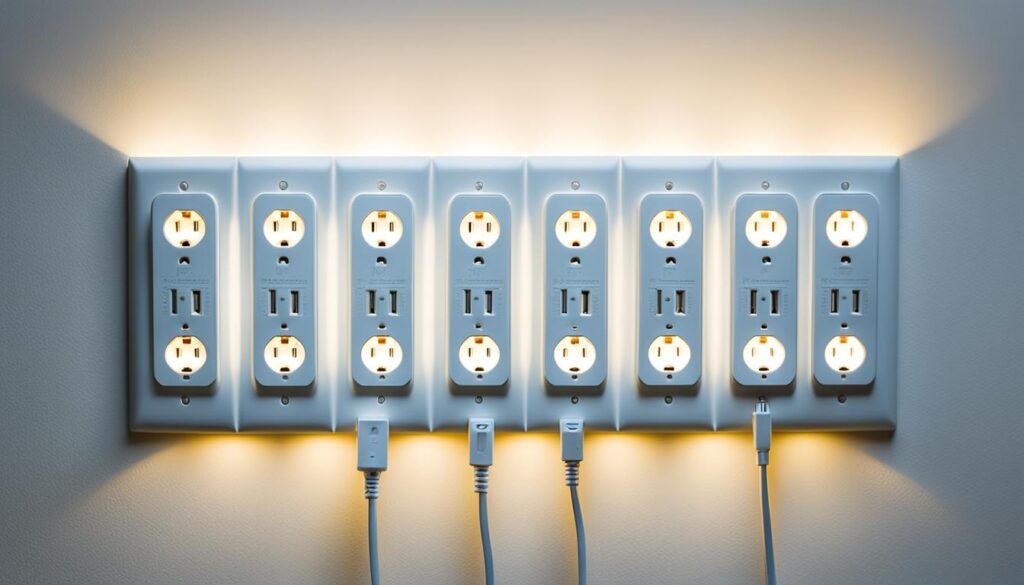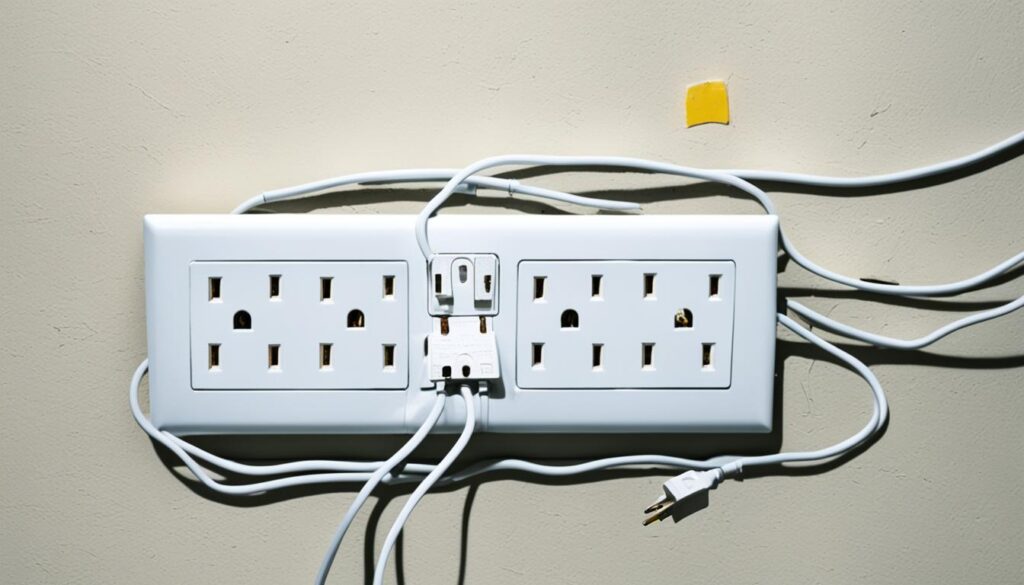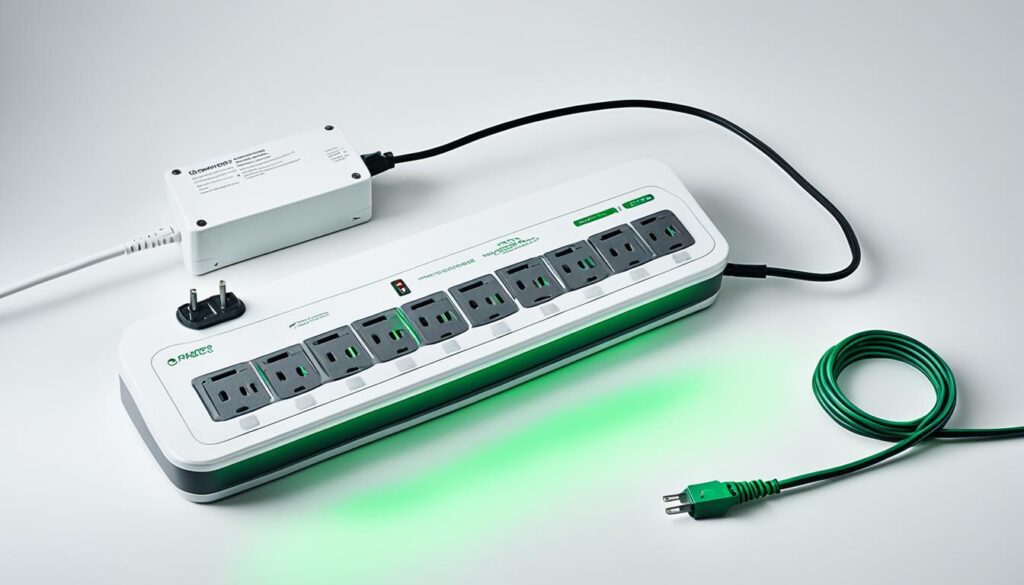Understanding the capacity of outlets and circuits is crucial for safe and efficient use of outlet power. By following the guidelines provided in this guide, you can maximize your electrical efficiency at home.
Key Takeaways:
- Knowing the capacity of your circuits can help you avoid overloading them.
- Most residential circuits are either 15 or 20 amps, with a maximum load of 1800 watts or 2400 watts respectively.
- Create a circuit map to determine the load distribution and prevent overloading outlets.
- Overloaded outlets can cause house fires and damage the electrical system.
- Be mindful of the amperage and total electrical load when using power strips and extension cords.
How Much Electricity Can an Outlet or Circuit Handle?
Understanding the capacity of outlets and circuits is crucial for safe and efficient use of outlet power. Each circuit in your home is designed to supply power to multiple outlets and lights. Overloading a circuit can cause the electricity to shut off in certain areas of your home, leading to inconvenience and potential electrical hazards.
It’s important to know the circuit capacity to avoid overloading. Most modern residential circuits can handle either 15 or 20 amps, with corresponding maximum loads of 1800 and 2400 watts respectively. These limits ensure that the circuit can safely deliver power to multiple devices without overheating or tripping the circuit breaker.
Continuous loads are an important consideration as well. These loads, which include devices that operate for extended periods like refrigerators or air conditioners, have a lower limit of 20% less than the maximum limit. Taking continuous loads into account is crucial to prevent overloading the circuit and ensure the safe and efficient operation of your electrical system.
To illustrate the circuit capacity, below is a table outlining the typical load limits of 15-amp and 20-amp circuits:
| Circuit Type | Maximum Amps | Maximum Watts |
|---|---|---|
| 15-Amp Circuit | 15 Amps | 1800 Watts |
| 20-Amp Circuit | 20 Amps | 2400 Watts |
Knowing the circuit capacity helps you make informed decisions about the electrical load you can connect to an outlet without risking overloading the circuit. Simply put, it allows you to use your electrical devices and appliances safely and efficiently.

Determining Outlet Capacity
When it comes to understanding the capacity of an outlet, considering the wattage of each device or appliance you plan to plug in is crucial. By doing so, you can prevent overloading the outlet and ensure safe usage.
Creating a circuit map is a highly recommended practice. This map helps you identify which outlets and lights are connected to the same circuit. It’s important to know this information to avoid overloading the circuit and tripping the breaker. Overloading a circuit can cause inconvenience and, in some cases, even damage to your electrical system.
Another important consideration is the type of bulbs you use in your home. LED bulbs and compact fluorescent bulbs are known for their energy efficiency and lower wattage. By switching to these types of bulbs, not only can you maximize energy efficiency, but you can also reduce the overall wattage demand on your outlets.
Remember, distributing the load properly across your circuits and utilizing energy-efficient bulbs can go a long way in preventing overloaded outlets in your home.
Benefits of LED and Compact Fluorescent Bulbs
- Lower wattage consumption compared to traditional incandescent bulbs
- Energy-efficient, resulting in reduced electricity bills
- Longer lifespan, saving money on replacements
- Environmentally friendly, with lower carbon emissions

| Appliance | Wattage |
|---|---|
| Refrigerator | 100-800 |
| Air Conditioner | 500-3500 |
| Microwave | 600-1200 |
| TV | 40-400 |
| Laptop | 20-90 |
Overloaded Outlets and Hazards
Overloaded outlets pose a significant risk of house fires and damaged wiring. When you plug in more appliances than the circuit can handle, it puts excessive strain on the electrical system, leading to potential hazards.
An overloaded outlet can overheat, causing the wiring within the wall to melt and potentially ignite a fire. This danger is particularly severe in older homes with outdated electrical systems.
In the event of a house fire due to an overloaded outlet, the consequences can be devastating. Not only can it destroy your property and valuable belongings, but it can also pose a grave threat to the lives of you and your loved ones.
There are several common signs that indicate an overloaded circuit:
- Tripping circuit breakers: If your circuit breaker frequently trips, it may be a sign that you have too many appliances or devices connected to a single circuit.
- Frequently blown fuses: Similar to tripping circuit breakers, blown fuses indicate that the circuit is unable to handle the electrical load.
- Flickering lights: When you notice your lights flickering or dimming, it could be a warning sign of an overloaded circuit.
If you observe any of these signs, it’s crucial to address the issue promptly. Ignoring an overloaded outlet can lead to irreparable damage to your electrical system and increase the risk of a devastating fire.
Take Action to Prevent Hazards
To mitigate the risks associated with overloaded outlets, it’s advisable to follow these steps:
- Limit the number of appliances and devices connected to a single outlet or circuit. Distribute the load across multiple circuits to avoid overburdening any one outlet.
- Consider upgrading your electrical system if you frequently experience overloaded outlets or if your home has outdated wiring. Consulting with a licensed electrician can help you determine if your home requires updates to ensure safety and compliance with current electrical codes.
- Incorporate power strips with built-in circuit breakers. These devices provide an extra layer of protection by automatically shutting off the power in case of an overload.

By proactively addressing overloaded outlets, you can safeguard your home and loved ones from the risk of a house fire and damaged wiring. Avoiding overloading circuits is a crucial step in maintaining a safe and reliable electrical system.
Power Strips and Extension Cords
When it comes to expanding the number of devices you can plug in, power strips and extension cords are essential. However, it’s important to understand their limitations to ensure safety and prevent electrical hazards.
The capacity of a power strip or extension cord is determined by its amperage rating and its ability to handle the electrical load. Exceeding the amperage rating can lead to overheating, potentially resulting in fire hazards. To avoid this, it’s crucial to know the amperage rating of the outlet, power strip, or extension cord you are using.
While it is possible to connect multiple power strips together through a process called daisy-chaining, it’s vital to consider the total wattage of the devices you plan to plug in. Daisy-chaining can increase the risk of overloading the electrical circuit and exceeding the power strip’s or extension cord’s capacity.
To calculate the total wattage, add up the wattage of each device you intend to plug in. Ensure that the combined wattage does not exceed the power strip or extension cord’s capacity. This will help prevent the circuit from becoming overloaded and minimize the risk of damage or fire.

Power Strip and Extension Cord Safety Ratings
| Product | Amperage Rating | Maximum Load (Watts) |
|---|---|---|
| Standard Power Strip | 15 Amps | 1800 Watts |
| Heavy-Duty Power Strip | 20 Amps | 2400 Watts |
| Standard Extension Cord | 10 Amps | 1200 Watts |
| Heavy-Duty Extension Cord | 15 Amps | 1800 Watts |
It’s worth noting that using high-power appliances, such as refrigerators or air conditioners, with power strips or extension cords is generally not recommended. These appliances often have a high wattage requirement, which can easily overload the circuit and pose significant risks.
Understanding the capabilities of power strips and extension cords and using them responsibly is crucial for ensuring the safe and efficient operation of your electrical devices.
Conclusion
Understanding the capacity of outlets, circuits, and power strips is crucial for safe power use and electrical efficiency in your home. By being mindful of the wattage of your appliances and distributing the electrical load properly, you can prevent overloading circuits and minimize the risk of fire hazards.
Remember to create a circuit map to identify which outlets are on the same circuit and could potentially be overloaded. This will help you make informed decisions about where to plug in your devices and appliances. Additionally, using energy-efficient bulbs such as LED or compact fluorescent bulbs can help maximize electrical efficiency and reduce your energy consumption.
Keep in mind that overloaded outlets can cause damage to your electrical system and increase the risk of a house fire. If you notice any signs of an overloaded circuit, such as tripping circuit breakers or flickering lights, it’s important to call a qualified electrician to inspect your home’s electrical setup.
By following these guidelines and practicing safe power use, you can ensure the longevity of your electrical system and enjoy a comfortable, efficient, and secure home environment.

